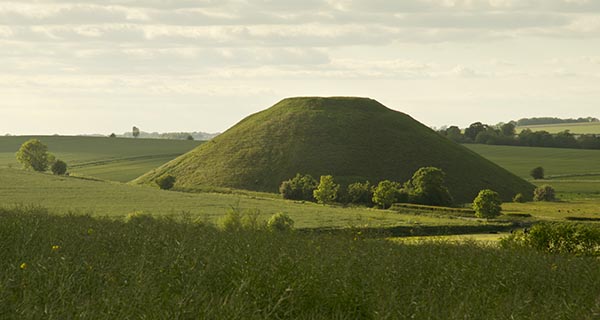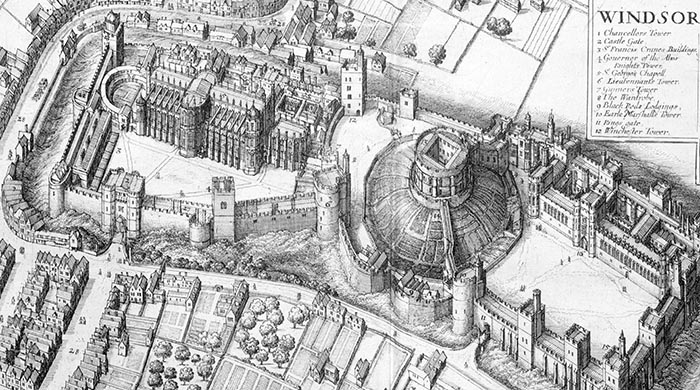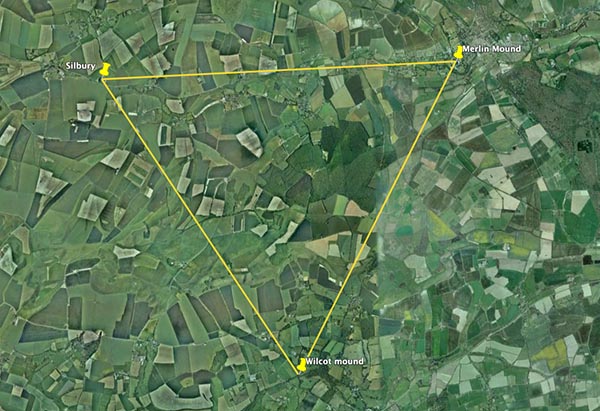DRUID WAYS AND LONDON'S LEYS
part III

Silbury Hill.

Silbury Hill.
When the three sites are connected, the area encompasses just about the oldest part of the ancient city of London. What suggests the alignment was not by accident is due to a fourth sacred mound, Penton, which sits precisely on the ley line between the Llandin and Bryn Gawr mounds. It is from this site that the London area of Pentonville takes its name. In Celtic, pen means head, ton means sacred mound, and by implication the name indicates a place of considerable importance.
Indeed, beneath the Penton lies a horizontal shaft leading to a cave, much like those found in temples and older churches throughout Europe, all of which were used for the practice of chthonic or Mithraic mysteries. The entrance has since been secluded behind a wall in Merlin’s Cave Tavern at the bottom of the hill. Traditions suggest the site was used into medieval times, when the monarch joined remaining Order of Druids to celebrate solar and lunar festivals. Afterwards, the delegation of bards and priests, along with the king in his chariot, convened a few miles north at the Llandin, where the celebration was solemnized in symbolic ritual on this ‘great seat of the monarch’. To reach it they travelled along Maiden Lane, still so named, a sanskrit root word meaning ‘an open place of public meeting’.
Before it was leveled to create a reservoir, Penton was dominated by a prehistoric stone circle and presumably oriented to the Beltane sunrise, the feast of fertility; the original approach to this once sylvan sanctuary, where the Elizabethan herbalist Gerard describes “white saxifrage growing in abundance,” it has since been replaced by one of London’s most dismal and depressing neighbourhoods. It seems that yet again the destruction of the sacred has attracted its very opposite. And yet even right up to the Second World War, the site could be appreciated, for it was located in accordance with Druid requirements for a sacred meeting place, that “a Gorsedd of the Bards [a Council in a high place] must be held on a green spot, in a conspicuous place in full view and hearing of the country and aristocracy, in the face of the sun, the eye of Light, under the expansive freedom of the sky, that all may see and hear.”
The site may also have served as an ancient observatory, given that a deep vertical shaft was found at the site, a feature common to many conical mounds in Britain. The design is similar to observational shafts used for astronomy in Egypt and India, even at the original Greenwich Naval Observatory in south west London. Today it sits beneath the floor of the famous Sadlers Wells Theatre.
But what makes the Penton mound a key indicator that London’s sacred mounds were carefully surveyed and deliberately aligned is that Penton mound rests precisely on the hypotenuse of the triangle. And not at the mid-way point, but where the longest line of the invisible triangle is cut by the Golden Ratio, nature’s harmonic, the very same mathematical proportion used throughout the ancient and classic world by architects of sacred buildings including Greek temples and Gothic cathedrals.
This deliberate use of mounds as markers of an ancient network is not confined to London but extends throughout the fertile British countryside, from the southern tip of Cornwall to the northernmost rock in Scotland. Perhaps the most celebrated of these is Silbury Hill, literally the ‘hill of Light’, which stands 75 miles west of the Tower of London. 132 feet high, sloped at 30º, and complete with its own vertical shaft, this artificial mound not only resembles a massive breast amid a landscape of grain, it is also one of the first local features to be blessed with the light of the Sun on the Winter Solstice. And just like its smaller counterparts in London, it is not alone; standing exactly 5.6 miles to the east is a replica, Merlin’s Mound, and to the south, also precisely 5.6 miles distant, is a third at Wilcot – or at least it was until engineers digging a nearby canal razed it and used its piled earth for an embankment.
Each mound stands on substantial and measurable lines of magnetic force, and from the air they impressively form a perfect equilateral triangle. But something rather magical happens when a ley line is connected between Silbury Hill and the Bryn Gawr mound in London: the line passes through two conical mounds at Windsor and Eaton.

An early view of the Windsor Mound, already with King Edward's tower superimposed.
Windsor – or Win-de-Sieur, meaning ‘white or holy mound of the Lord’ – is the seat of British monarchy and the only known sacred gathering site which in unbroken historical continuity has fulfilled its Celtic title as a ‘great assembly of power’ from the 6th century to the present day. As we read earlier, this association with kingship is also synonymous with Bryn Gawr in London, just as it is with Silbury Hill, which legend states to be the resting place of King Sil; thus all three mounds are aligned by history, function and ley.
Ironically, the Windsor sacred mound – which Edward III’s round tower now graces – became the focus of attention of King Arthur when he attempted to reorganize the defunct Druidic Order, using it as a talisman by announcing a return of the Druidic custom of celebrating festivals on the summits of sacred mounds, just as their forefathers before them had done. And so Arthur’s favourite gathering place at the Summer solstice was this ‘Round Table Mound’ in Windsor.
A quarter of a mile away stands Eton – or Ea-ton, as it was in the 15th century – named after its own sacred mound. Both the Beltane festival as well as the solstices were honoured here, hence why the mound was renamed in Roman times Sol’s Hill (sol referring to solar), later corrupted to Salt’s Hill. The two mounds are bisected by the curving River Thames like two stars either side of the Milky Way. Perhaps, like the dual-purpose sites in London, a Druid circle and college also existed here, a tradition that continues at Eton College, one of the most celebrated seats of education in England.
This ley and triangle alignment of London’s oldest known sacred mounds is but a glimpse of the blueprint once laid down in these islands by a culture now gone and forgotten, and which by the time of the earliest Celtic kings was already considered ancient. But it seems that everywhere you look in and around London, both the Druids and their predecessors never really went away.
Return to Articles

Silbury - Wilcot - Merlin's Mount. Three identical mounds arranged in a perfect triangle.